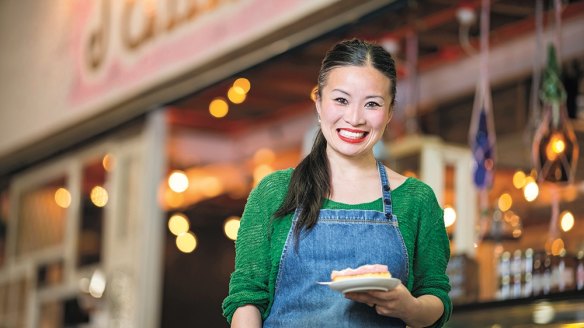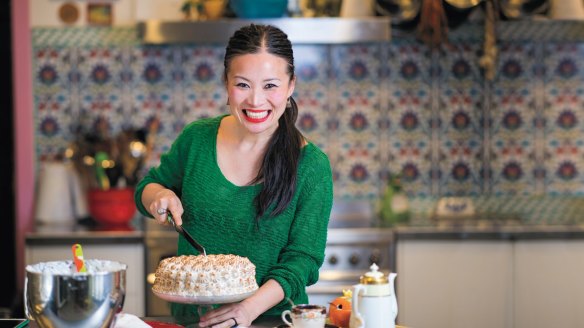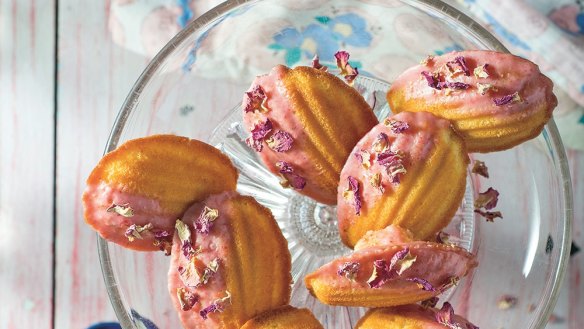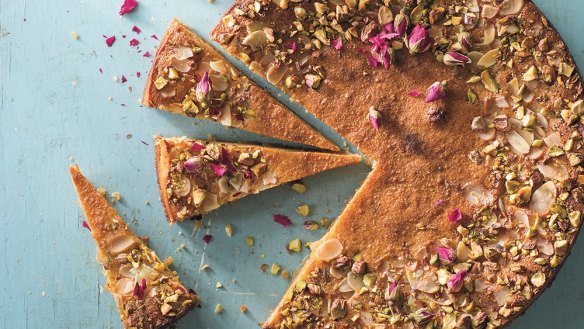Three sweet treats from Poh Bakes 100 Greats by Poh Ling Yeow

Poh first fell in love with food by learning to bake as a nine year old. She remembers vividly her mum showing her the art of folding flour into her first sponge cake "just like so" and the skill in lining a tin meticulously.
Now, years after Poh's meteoric rise to fame through MasterChef, and hosting her own television shows, Poh's Kitchen and Poh & Co, she returns to her roots with wooden spoon and mixing bowl in hand, in Poh Bakes 100 Greats.
Persian Love Cake

Feeds 12
Think those golden baklava-ish flavours, but in a moist cake with sticky, dark caramelised sides. This is a cake to make if you are usually bad at making cakes. Two pluses: it uses a muffin method (what I call a "bung-in-and-stir"), which requires very little to no technique, and is a wonderful gluten-free option.
Crumb base

300g almond meal
185g raw caster sugar
220g soft brown sugar

120g unsalted butter, melted
Cake batter
2 eggs, lightly beaten

250g natural or Greek-style yoghurt
1/8 tsp salt
1 tsp ground cardamom
2 tsp rosewater
25 saffron threads
3 tbsp flaked almonds
3 tbsp pistachio nut kernels, roughly chopped
To decorate (optional)
Unsprayed edible rose petals
To serve
500g Greek-style yoghurt
Preheat the oven to 170C fan-forced. Grease the ring of a 24cm springform tin, then line with strips of baking paper. Turn the base upside down, so it no longer has a lip. Place a piece of baking paper over it, then clamp the ring around it to secure.
To make the crumb base, combine the almond meal, caster sugar, brown sugar and butter in a large mixing bowl, and rub together until you have an even, sandy consistency. Divide the mixture in two, and tip half into the prepared tin. Using the back of a spoon or a spatula, press the crumb mixture evenly over the bottom of the tin.
To make the cake batter, add the eggs, yoghurt, salt, cardamon, rosewater and saffron to the remaining crumb mixture and whisk until there are no lumps. Pour over the crumb base and sprinkle the flaked almonds and pistachio nuts over the top. Bake for about 20 minutes until golden and fully risen – you will know because the top will probably crack a little. If the top is colouring too quickly, cover with foil, then bake for a further 20 minutes. The centre of the cake should spring back when pressed gently. Cool completely, before removing from the tin and cutting to serve.
Lovely decoration ideas are edible rose petals, sliced fresh figs and a very light dusting of icing sugar. Serve with a dollop of Greek style yoghurt.
Portuguese Custard Tarts
Makes 16 individual tarts
There are two significant things that make these no ordinary custard tarts. One is the use of puff pastry instead of a shortcrust, the other is that this is not just regular puff, but puff that's layered with cinnamon. The pastry is then rolled into a cylinder, cut into discs and pushed into the moulds so that the layers bake radiating outwards like the rings of a tree. For a different nuance, you can use ground cardamom instead of cinnamon.
1 quantity Rough Puff Pastry (see below)
1-2 tsp ground cinnamon or ground cardamom + extra, to sprinkle
Custard
600ml milk
2 eggs + 2 extra yolks
2 tsp vanilla extract or vanilla essence
170g caster sugar
2 1/2 tbsp wheaten cornflour (cornstarch)
To make the custard, microwave the milk in a heatproof bowl for 3 minutes on the highest setting. In another medium mixing bowl, whisk the eggs, extra yolks, vanilla and sugar until pale and fluffy.
Add the cornflour, and whisk until smooth. Pour into the hot milk, and whisk briefly to combine, then microwave for 2 minutes. Whisk well until smooth. Buzz in the microwave for another 1 1/2 minutes, or until a thick paste forms. Whisk madly again, until completely smooth. Press some plastic wrap directly over the surface of the custard, and chill completely – about 2 hours.
Preheat the oven to 210C fan-forced. Have two standard 12-hole muffin tins on standby.
To make the tart shells, roll out the puff pastry into a 30 x 40 cm rectangle. Sprinkle the ground cinnamon evenly across the surface, and roll snugly into a log. Slice the log into 16 even pieces. Place a piece of pastry into each of 16 muffin holes, with the spiral facing upwards. Tuck the "tails" underneath, then press and massage the pastry to line each hole completely, with a bit of overhang to make up for shrinkage.
Fill each pastry shell with about a tablespoonful of the custard, and bake for about 30 minutes until the pastry is beautifully golden brown and the custard dotted with black spots. Remove from the oven. Gently remove the tarts from the muffin tin, and cool on a wire rack.
Just before serving, sprinkle each tart with a bit more cinnamon. These keep well in a cake tin for up to 5 days if stored in the refrigerator. Just refresh them in the oven for 10 minutes at 170C fan-forced if you want to eat them warm.
Rough Puff Pastry
250g unsalted butter, chilled
250g plain flour
1 tsp salt
120ml cold water
Cut the butter into 2cm dice. Combine the butter, flour and salt in a food processor. Pulse for 1-2 seconds until you see the butter has broken down into roughly 1cm chunks. Tip the mixture into a medium mixing bowl. Drizzle the cold water evenly in concentric circles over the mixture, then gather the crumbs in a circular motion, squeezing them together until you have a rough mass that is mostly sticking together.
To laminate the dough, flour your work surface well, place the dough on it and shape into a rectangle, with the longer part placed vertically in front of you. Don't be concerned if the dough looks a crumbly mess of wet and dry bits, as long as it's generally holding together. Begin to roll the dough so it's just over double in length than it is wide, then fold into thirds. Always pat the sides inwards to make sure you have a nice, uniform rectangle to work before you start the next "turn". Turn the dough 90 degrees clockwise and repeat this process another two times. Rest in the refrigerator for 30 minutes.
Madeleines with strawberry rosewater glaze
Makes about 12
The brilliant thing about these little French butter cakes is that they age so well but, if you eat them soon after they come out of the oven, you'll catch that small window of crispy-edged goodness that can only be experienced if you're an enthusiastic baker – or at least related to one!
100g plain flour
1 tsp baking powder
120g caster sugar
2 eggs, lightly whisked
140g butter, melted
1/2 tsp finely grated lemon zest
Strawberry Rosewater Glaze
60-90g pure icing sugar, sifted
4-6 strawberries, mashed and passed through a sieve
1 tsp rosewater
In a medium mixing bowl, combine the flour, baking powder and sugar. Mix with a wooden spoon, then add the eggs, butter and lemon zest. Stir until smooth, then transfer the batter to a piping bag, and refrigerate for 2 hours.
Preheat the oven to 200C fan-forced. Grease a 12-hole madeleine tin well.
Pipe a small amount of the batter into each mould, filling them only two-thirds of the way. Reduce the oven temperature to 180C fan-forced, and bake for 10 minutes until the madeleines are golden. As soon as they come out of the oven, smack the edge of the tray onto the work surface to unmould the cakes. If you wait for just a split second too long, you'll find they stick very quickly and you will chuck a tanty like I did the first time I made them because I didn't have this critical bit of information! Allow to cool completely on a wire rack before glazing.
To make the strawberry rosewater glaze, combine the icing sugar, strawberry purée and rosewater in a small bowl, then stir until smooth and quite runny. If it's too thick, mash more strawberries to add to the mixture. Dip just half of each madeleine into the glaze diagonally, then let the glaze set before serving. These keep well for up to a week in an airtight container.
Images and recipes from Poh Bakes 100 Greats by Poh Ling Yeow. (Murdoch Books, $39.99.) Photography by Alan Benson.
The best recipes from Australia's leading chefs straight to your inbox.
Sign up